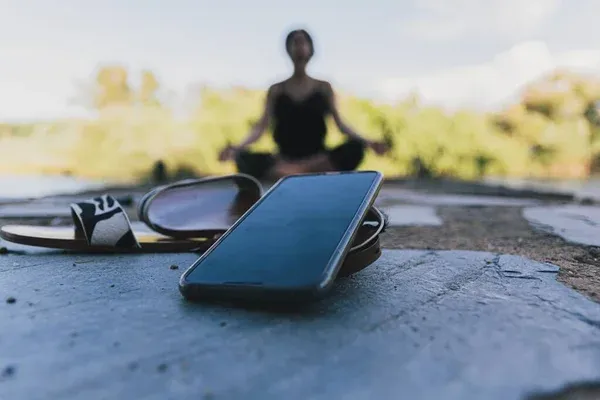Setting boundaries: Maintaining mental wellness in a digital age

Nowadays everyone is surrounded by multiple digital devices at all times. With the constant bombardment of notifications on various devices, it can get overwhelming for many. It is important to limit one’s exposure to these screens. Employees working corporate jobs may feel this way especially due to the demanding 9-to-5 jobs. This can provide the break needed to maintain mental wellbeing.
Keeping healthy boundaries with digital devices can be achieved by following simple tips. However, to overcome digital distractions it is essential to understand why digital overload is bad for us. This blog will provide an in-depth explanation of what digital overload is, and how to set healthy technology boundaries while prioritizing wellbeing.
Understanding digital overload
The brain has limited capacity when it comes to processing information. Since digital devices tend to provide such a large amount of information at once, it can be overstimulating for the brain. The devices often provide more information than the brain is optimized to handle at once. This can lead to a digital overload.
Digital overload can be harmful to one’s wellbeing. It can negatively impact one’s daily life as well. People suffering from digital overload tend to have higher irritability, anxiety, vision problems, mood swings, burnout, and sleeping difficulties. These issues will interfere with personal interactions and professional productivity. However, setting technology boundaries can help maintain a healthy relationship with digital interactions. It is important to address this issue early on.
Setting technology boundaries
There are a few tips to follow when setting technology boundaries. These are simple tips that are easy to follow with a little bit of effort. Here are the tips below:
Out of sight, out of mind: Putting digital devices out of arm’s length can greatly benefit taking a digital break. Often the notifications coming through paired with the easy access to the devices compel people to pick up their digital devices. Keeping it at a distance can avoid extra unnecessary screen time.
Avoid multitasking: Multitasking can cause more information processing power from the brain. This can lead to faster burnout and ultimately, technology overload. Avoiding multitasking can allow the brain to focus on a task at a time and allow information processing at an optimized level.
Schedule digital interactions: Scheduling digital interactions can be the perfect to induce a controlled environment for digital interactions. Timing them will allow one to mentally prepare to begin and end digital interactions which can help avoid digital overload.
Emails, not texts: Professional lives can often swarm people’s lives. Emphasizing that emails should not be treated like text messages is important. One should be on emails during work hours and normalize not attending to emails right away, unlike text messages which are designed for personal and more urgent information.
Turn on Flight Mode: The flight mode option on phones disables network and wifi connections. This can help unplug and get off of social media. Social media can cause the fear of missing out, or FOMO watching peers do ambitious things. It can mentally drain a person which can contribute to burnout. Turning flight mode on can give a much-needed break from social media.
Hone hobbies: Focusing on non-digital hobbies can help divert attention from devices.
Prioritizing wellbeing
While following the tips to maintain a healthy digital relationship, it is also important to prioritize wellbeing. In doing so, one can avoid further digital distractions resulting in the prevention of digital overload. Let’s take a look at the list of tips to prioritize wellbeing:
Create a healthy work-life balance: A healthy work-life balance is important for mental wellness. Setting up healthy work boundaries can enhance personal life matters and help focus on mental wellbeing. One can achieve this by keeping designated work areas and hours. This will help the team collaborate with timings that work for all. Furthermore, avoiding work tasks outside of these dedicated hours and space can save the stress from professional lives.
Practice Mindfulness techniques: Many mindfulness techniques practiced in daily life are aimed at managing stress from professional and personal lives. Breathing exercises, meditation, yoga, and reading are some examples of mindfulness practices. Incorporating this into daily life can help mitigate everyday stress.
Engage in offline activities: Engaging in tasks that do not require exposure to digital screens can be beneficial to mental wellbeing. Practicing hobbies can provide much-needed relaxation and fulfillment while filling out personal obligations like important family commitments. Camping with family and friends, attending social events, going on hikes, and baking with loved ones are all examples of offline activities that can prioritize wellbeing.
Conclusion
Setting boundaries in the digital age can provide the much-needed break employees need today. Employees are made to overwork more often than not these days, and prioritizing wellbeing can take them a long way. Following small tips to avoid digital burnout can overall contribute to maintaining a healthy wellbeing level at all times. These tips are small and can be easily incorporated into daily life without interfering with efficiency. It can improve both professional and personal lives setting boundaries that can push productivity and job satisfaction higher. It is recommended to implement the tips as it can avoid mental exhaustion and as always, prevention is better than cure.
FAQs
Why is setting technology boundaries important for mental wellness?
Setting technology boundaries helps reduce digital overload, minimize stress, and improve overall mental health.
What are some practical tips for managing digital overload?
Practical tips include establishing screen-free zones and times, implementing regular digital detoxes, and managing notifications and alerts effectively.
How can I create a healthy work-life balance in the digital age?
Create a healthy work-life balance by setting clear boundaries between work and personal life, establishing a designated workspace, and avoiding work-related activities outside defined work hours.
What are some effective relaxation techniques for improving mental health?
Effective relaxation techniques include mindfulness practices such as meditation, deep breathing exercises, and yoga, which can reduce stress and promote mental well-being.


